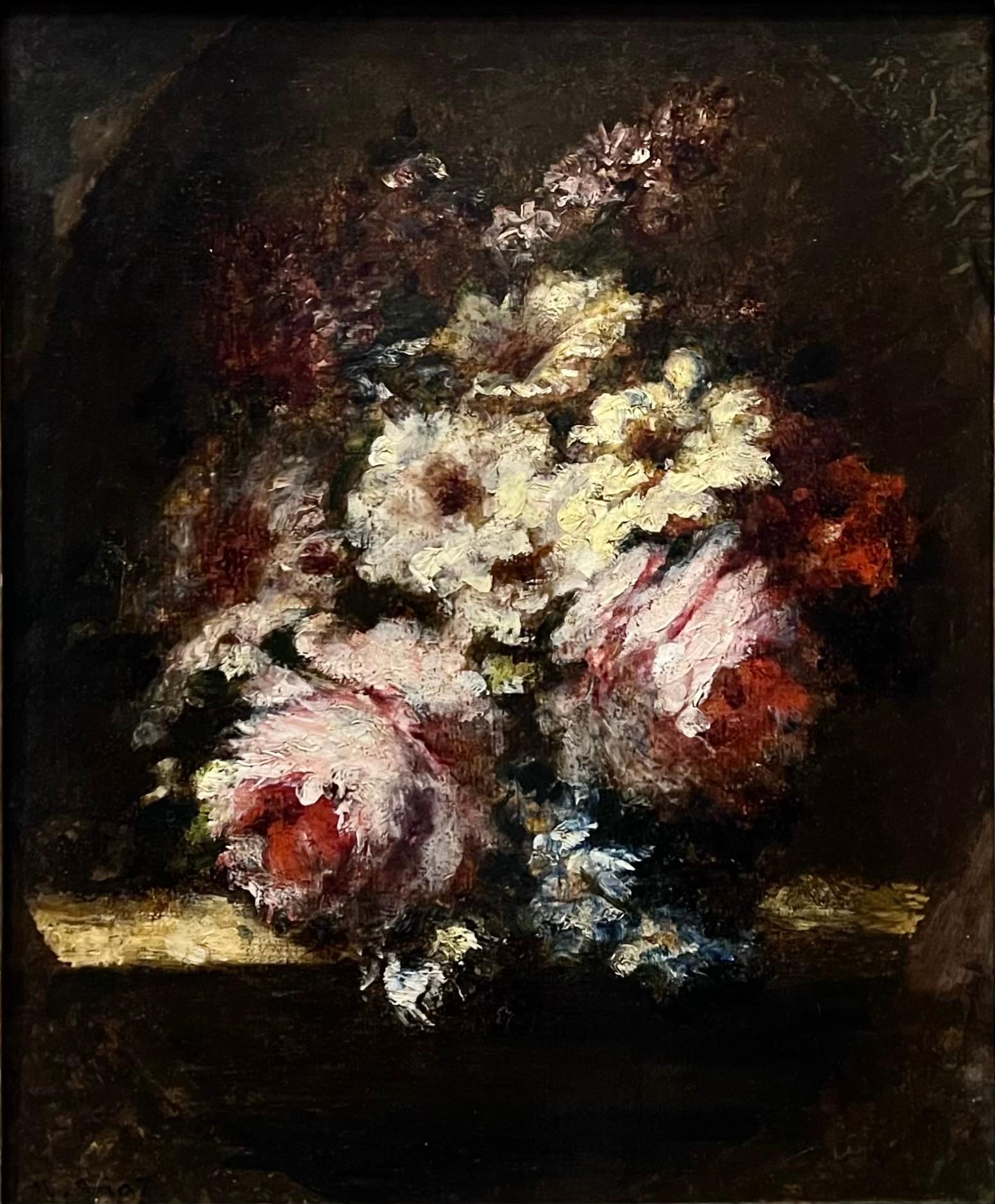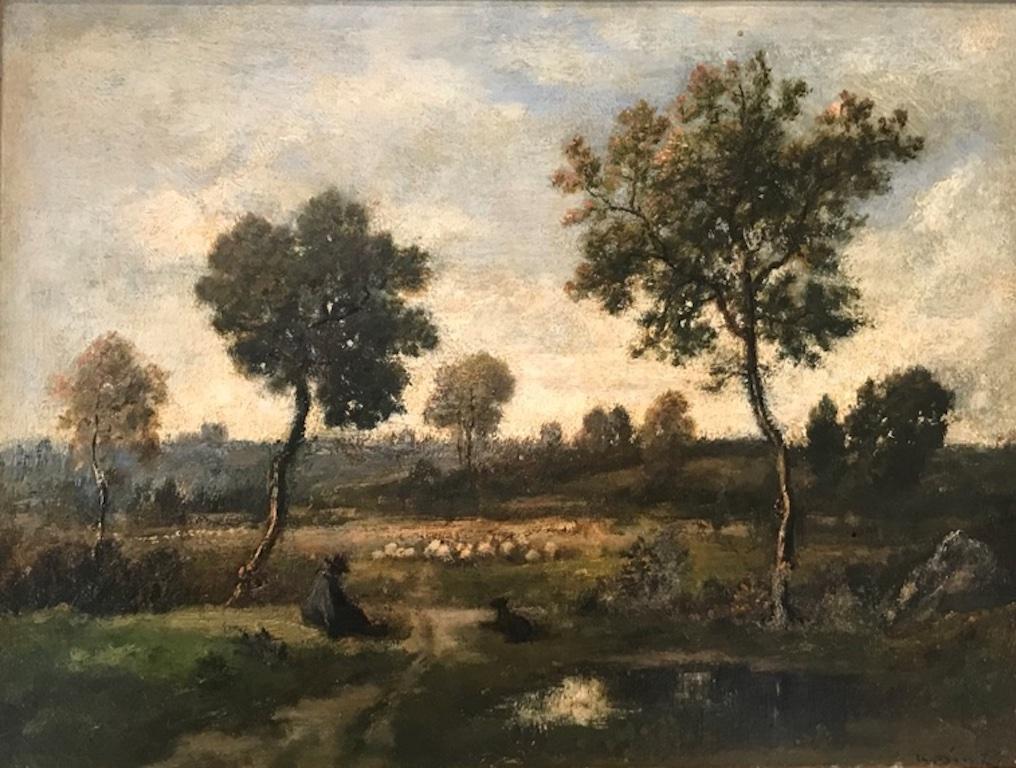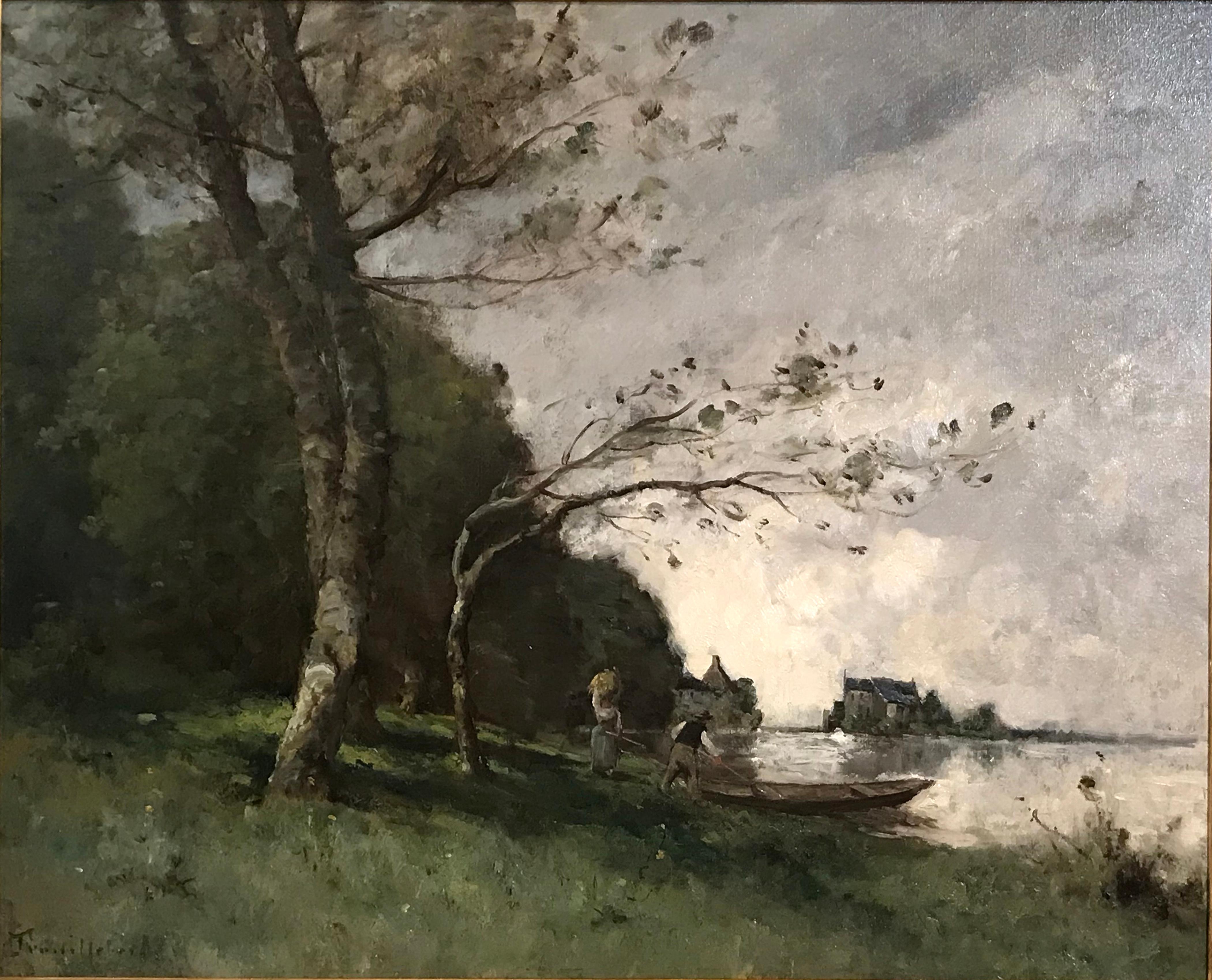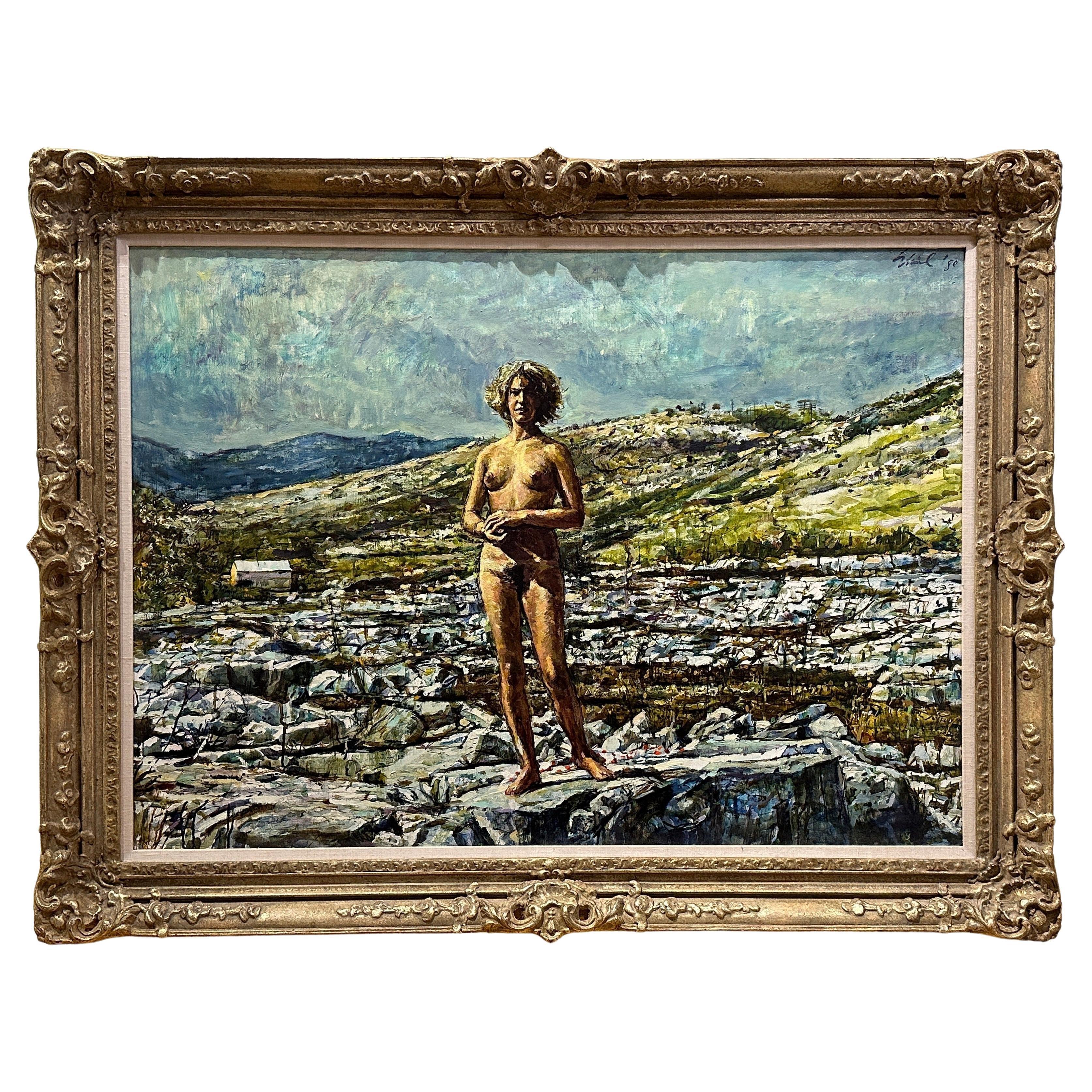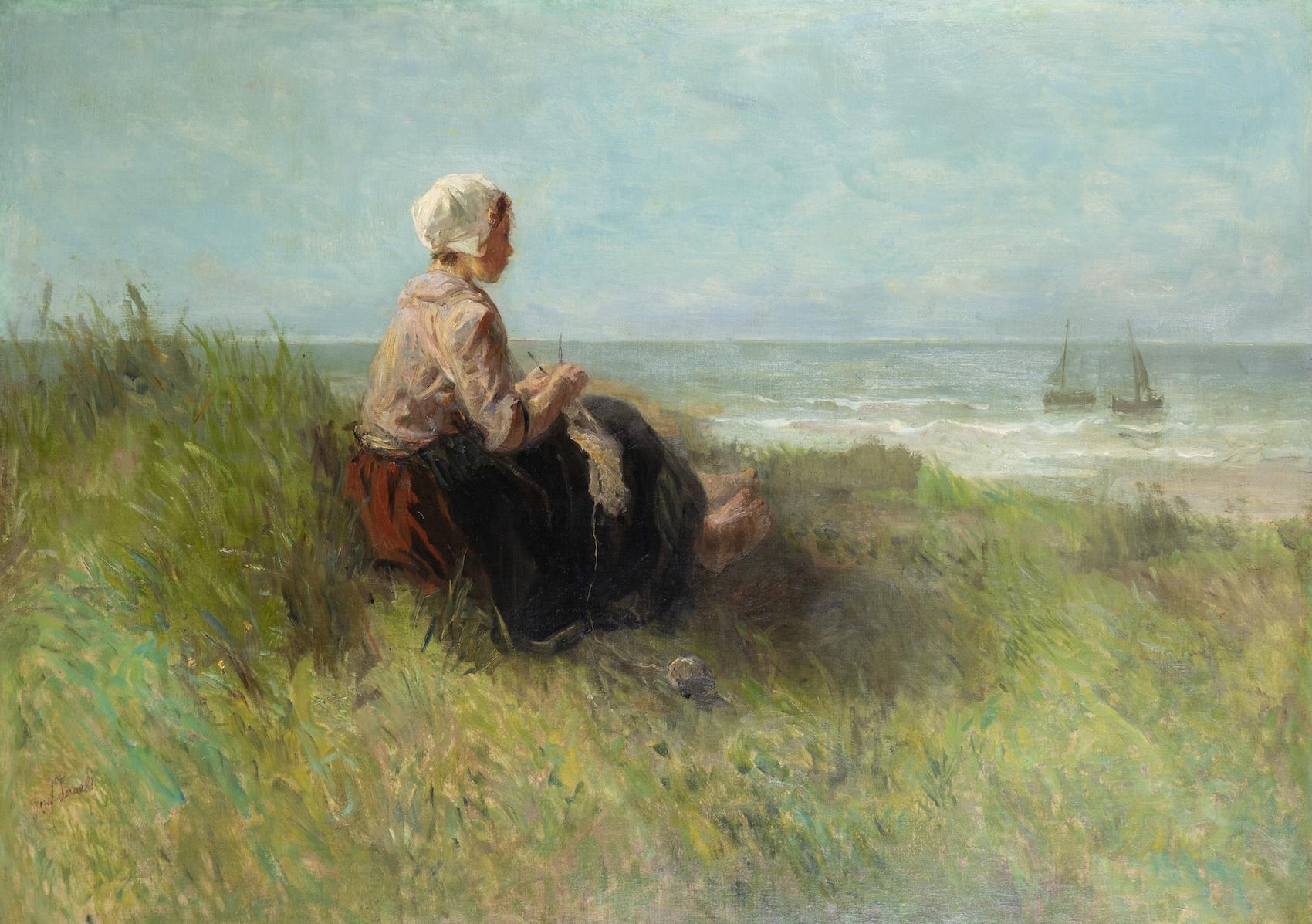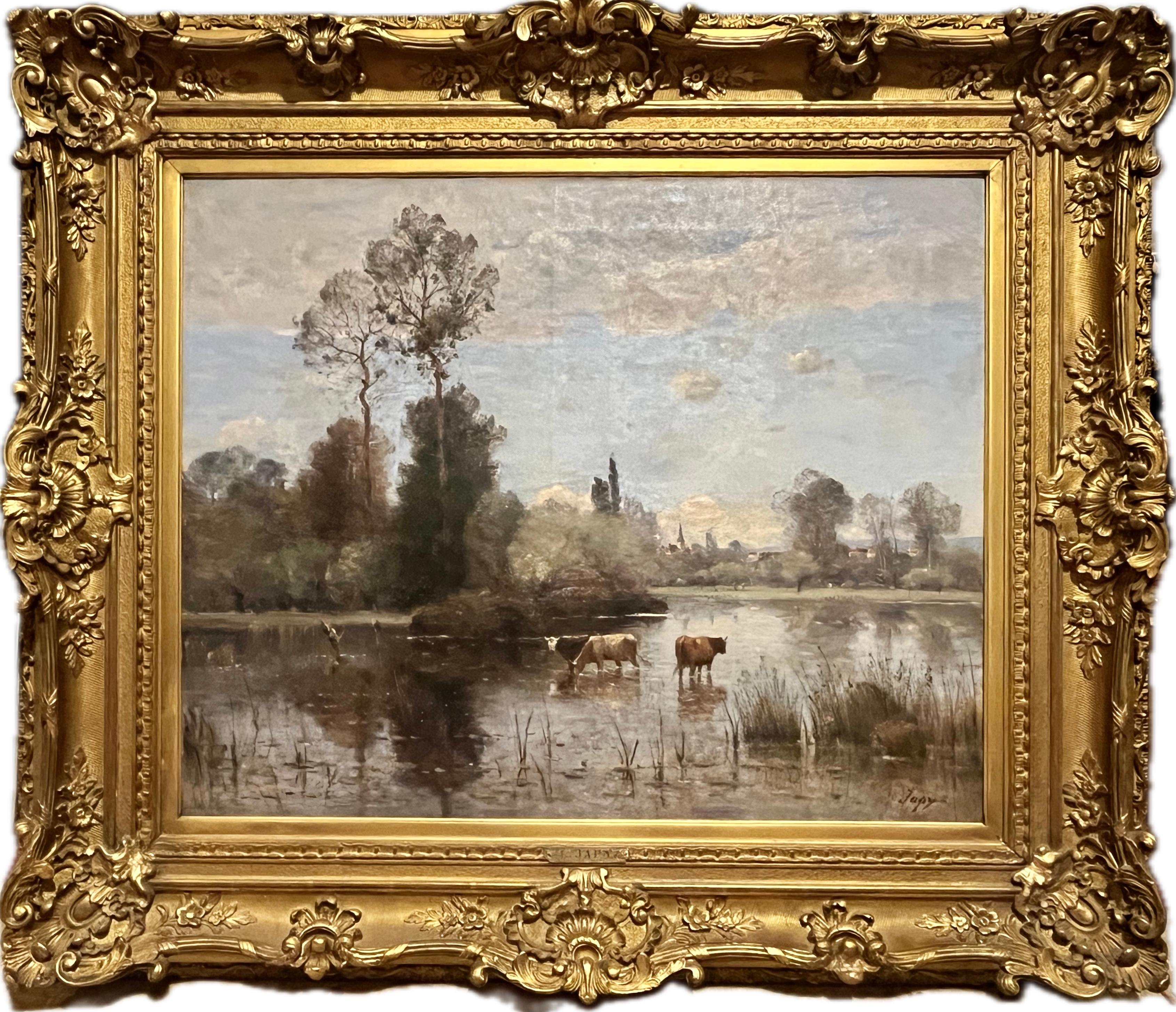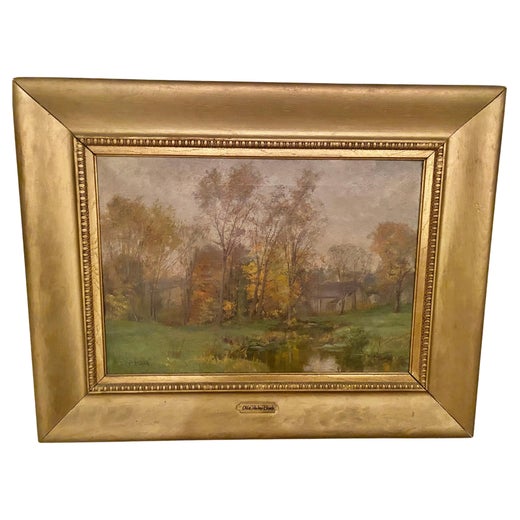Items Similar to "Verdant Landscape with Stream, " Olive Parker Black, Barbizon, Female Artist
Want more images or videos?
Request additional images or videos from the seller
1 of 9
Olive Parker Black"Verdant Landscape with Stream, " Olive Parker Black, Barbizon, Female Artist
About the Item
Olive Parker Black (1868 - 1948)
Verdant Landscape with Stream
Oil on canvas
16 x 24 inches
Signed lower left
n accomplished landscape painter, Olive Black was born in Cambridge, Massachusetts. She studied art with Hugh Bolton Jones at the Art Students League and with William Merritt Chase and Edwin Blashfield at the New York National Academy of Design in New York. She was considered one of Chase's best students and likely attended the Shinnecock Summer School of Art, which became known as Chase's school and was primarily attended by women.
She combined the impressionism learned from him with Barbizon school influence from Jones. She exhibited at the National Academy of Design from 1897 to 1930 and also exhibited in Boston and Philadelphia. To 1910, she lived in Cambridge, Massachusetts and then moved to New York City where she exhibited at the National Academy of Design from 1897 to 1930. She also exhibited with the Boston Art Club, the Art Club of Philadelphia and the Carnegie Institute.
She was a member of the National Association of Women Artists, the New York Society of painters, American Artists Professional League and the Copley Society in Boston.
- Creator:Olive Parker Black (1868 - 1948, American)
- Dimensions:Height: 16 in (40.64 cm)Width: 24 in (60.96 cm)
- Medium:
- Movement & Style:
- Period:
- Condition:
- Gallery Location:New York, NY
- Reference Number:1stDibs: LU1841210495162
Olive Parker Black
Olive Parker Black was a 19th-century American visual artist who was born in 1868. Numerous works by the artist have been sold at auction, including Cattle Crossing a Bridge sold at Bonhams San Francisco California and American Paintings and Sculpture in 2007 for $16,800. Black died in 1948.
About the Seller
5.0
Platinum Seller
These expertly vetted sellers are 1stDibs' most experienced sellers and are rated highest by our customers.
Established in 2021
1stDibs seller since 2022
63 sales on 1stDibs
Typical response time: <1 hour
- ShippingRetrieving quote...Ships From: New York, NY
- Return PolicyA return for this item may be initiated within 3 days of delivery.
More From This SellerView All
- "Flushing Landscape with Cows, " Charles Henry Miller, Barbizon, Rural FarmBy Charles Henry MillerLocated in New York, NYCharles Henry Miller Flushing Landscape with Cows, circa 1880 Signed lower left Oil on canvas 13 x 19 inches Charles Henry Miller was a noted artist and painter of landscapes from Long Island, New York. The American poet Bayard Taylor called him, "The artistic discoverer of the little continent of Long Island." Miller was educated at Mount Washington Collegiate Institute, and graduated in medicine at the New York Homeopathic Institute in 1864. Before his graduation, he had occasionally painted pictures, and in 1860 he exhibited The Challenge Accepted at the National Academy of Design, in New York City. He lived in Queens at the summer estate, Queenslawn, originally purchased by his parents. He went abroad in 1864 and again in 1867, and was a pupil in the Bavarian Royal Academy at Munich under the instruction of Adolf Lier...Category
1880s Barbizon School Landscape Paintings
MaterialsCanvas, Oil
- "Fruit" Georgina Klitgaard, Apples and Pears Still Life, Woodstock Female ArtistBy Georgina KlitgaardLocated in New York, NYGeorgina Klitgaard Apples and Pears Still Life Signed lower right Oil on canvas 8 x 10 inches Georgina Klitgaard’s art has sometimes gotten lost in the critical propensity to assign artists to membership in one school or another. Unfortunately for her posthumous reputation, Klitgaard defied easy characterization. She was a U.S. modernist, working in both oil and watercolors, but never abandoned figurative painting. She made her reputation in landscape but also excelled in portraits, flower studies, and even cityscapes. Yet despite Klitgaard’s ambiguous status in art history, her paintings continue to fascinate viewers attracted to the unsteady ground between twentieth-century realism and expressionism. Georgina Klitgaard (née Berrian) was born in Spuyten Duyvil, New York (now part of the Bronx); the Berrians had lived in the area since at least the U.S. Revolution. After graduating from Barnard College, she studied art at the National Academy of Design. In 1919 she married Kay Klitgaard, a Danish artist and writer. The next year, her life took a decisive turn when the couple visited friends in Woodstock, NY—about 120 miles north of New York City--and fell in love with the area. In 1906, L. Birge Harrison helped found the Art Students League Summer School in Woodstock and the area became a magnet for landscape painters. The Klitgaards bought a house in 1922 on a steep ledge at the end of Cricket Ridge, high above Bearsville, which provided panoramic vistas overlooking the Catskill Mountains and the Hudson Valley. Klitgaard joined the artists’ colony in the area, which at the time included artists Ernest Fiene and Katherine Schmidt. Klitgaard exhibited widely and her career slowly developed momentum. She was a regular contributor at Whitney Museum shows from 1927 to 1944. In 1929, she exhibited a painting entitled “Carousel” in the Whitney Studio Club’s famous exhibition “Circus in Paint.” Gertrude Vanderbilt Whitney acquired five paintings by Klitgaard in the early 1930s and served as a significant patron for the artist. Klitgaard s New York dealer, Frank Rehn...Category
Early 20th Century Modern Still-life Paintings
MaterialsCanvas, Oil
- "Tree, Trunk, and Roots, New York" Joseph Stella, American ModernismBy Joseph StellaLocated in New York, NYJoseph Stella (1877 - 1946) Tree, Trunk, and Roots, Bronx, New York, circa 1924 Oil on canvas 12 x 16 inches inscribed in another hand Joseph Stella/Estate and bears Joseph Stella Estate stamp (on the reverse) Provenance: The Estate of the Artist Rabin & Kreuger, New Jersey Parke Bernet Galleries, New York, March 14, 1968, Lot 147 ACA Galleries, New York Thence by descent Stella was born June 13, 1877 at Muro Lucano, Italy, a mountain village not far from Naples. He became painter laureate of Muro Lucano when he was in his teens with a representation of the local saint in the village church. Stella immigrated to America in 1896 and studied medicine and pharmacology, but upon the advice of artist friend Carlo de Fornaro, who recognized his undeveloped talent, he enrolled at the Art Students League in 1897. Stella objected to the rule forbidding the painting of flowers, an indication of his lifelong devotion to flower painting. He also studied under William Merritt Chase in the New York School of Art and at Shinnecock Hills, Long Island in 1901-1902, displaying the bravura brushwork and dark Impressionist influence of Chase. Stella liked to paint the raw street life of immigrant society, rendering this element more emotionally than the city realists, the Aschcan School headed by Robert Henri. Stella went through a progression of styles--from realism to abstraction--mixing media and painting simultaneously in different manners, reviving styles and subjects years later. The "Survey" sent Stella to illustrate the mining disaster of 1907 in Monongah, West Virginia, and in 1908 commissioned him to execute drawings of the Pittsburgh industrial scene. Steel and electricity became a major experience in shaping his responses to the modern world, and Stella succeeded in portraying the pathos of the steelworkers and the Pittsburgh landscape. Stella went abroad in 1909 at the age of thirty-two, lonely for his native land. He returned to Italy, traveling to Venice, Florence and Rome. He took up the glazing technique of the old Venetian masters to get warmth, transparency, and depth of color. One of Stella's paintings was shown in the International Exhibition in Rome in 1910 and was acquired by the city of Rome. The influence of the French Modernists awakened his dormant individuality. His friendship with Antonio Mancini, a Futurist, also played a role in his new style. At the urging of Walter Pach...Category
1920s American Modern Landscape Paintings
MaterialsCanvas, Oil
- "Mount Rockwell, Glacier National Park, Montana, " Mountain Lake Landscape ViewBy Charles Warren EatonLocated in New York, NYCharles Warren Eaton (1857 – 1937) The Shadow of Mount Rockwell, Glacier National Park, Montana, 1921 Oil on canvas 20 x 24 inches Signed lower right: CHAS WARREN EATON. Provenance: The artist The Macbeth Gallery, New York Private Collection Sotheby's New York, American Art, April 14, 1989 ConocoPhillips, Houston Simpson Galleries, Houston, Fine Art & Antiques, May 18, 2019, Lot 447 Exhibited: New York, The Macbeth Gallery, Paintings of Glacier National Park by Charles Warren Eaton, December 13, 1921 - January 2, 1922, no. 2. Literature: "Two Exhibitions at Macbeth's," American Art News, New York, Vol. XX, No. 10, December 17, 1921. A contemporary critic wrote that the paintings of Charles Warren Eaton appeal to “the dreamers who find in them the undiscovered scenes in which their fancy long has dwelt.” Eaton’s contemplative landscapes exude a spiritual quality that moves the observer into a similar frame of mind. He loved to depict the ethereal light of dawn and dusk in late autumn or winter, usually without any reference to human or animal figures or buildings. These Tonalist paintings, with their subdued palette and relatively intimate scale, marked a definite break with the fading popularity of the panoramic and romantic views of the Hudson River School painters. Charles Warren Eaton was born in Albany, New York to a family of limited means. He began painting while working in a dry-goods store. At age 22, he enrolled at the National Academy of Design in New York City and then studied figure painting at the Art Students League. By 1886, he was successful enough to quit his day job and make a living as a landscape painter. That year, he traveled to Europe with fellow Tonalist painters Leonard Ochtman and Ben Foster. In France, Eaton visited popular artist’s spots such as Paris, Fontainebleau and Grez-sur-Loing, and fell in love with the loose brushwork and moody style of French Barbizon painting. Returning to the United States, Eaton fell under the spell of George Inness, the foremost exponent of Barbizon style in the United States. In 1888, Eaton settled near Inness in Bloomfield, New Jersey, where Eaton lived until his death in 1937. In this period, he painted shadowy and ambiguous landscapes inspired by rural scenery in the northeastern United States. His signature theme was a cropped view of the branches, trunks, and foliage of a pine grove silhouetted against a delicately illuminated sunset or moonlit sky. He painted this vision so often between 1900 and 1910 that he picked up the sobriquet ‘‘The Pine Tree Painter.” After 1910, Eaton responded to the popularity of Impressionism by using brighter colors and painting sunlit daytime scenes. In 1921, he was hired to paint Glacier Lake, in Glacier National Park by the Great Northern Railroad Company as part of their ‘See America First’ campaign. He produced more than 20 paintings, among the artist's last works, that now poignantly remind viewers of the vast disappearing glaciers. Eaton tended to approach this mountain scenery from an oblique vantage point; he liked to capture small episodes, showing mountaintops nearly obscured by dramatically attenuated screens of fir trees. Eaton, like many Tonalist artists of his generation such as Henry Ward Ranger, John Francis Murphy, and Charles Melville Dewey...Category
1920s Tonalist Landscape Paintings
MaterialsCanvas, Paint, Oil
- "Untitled" Swirling Abstract Oil on Canvas, Indonesian School of AffandiLocated in New York, NYIn the manner of Affandi Abstract Lotus, circa 1970 Unsigned Oil on canvas 30 x 40 inchesCategory
1970s Abstract Abstract Paintings
MaterialsCanvas, Oil
- "Floral Still Life Arrangement" Frederick Jessup, Butterflies, Wine BottleBy Robert JessupLocated in New York, NYFrederick Arthur Jessup Still Life Arrangement Signed lower left Oil on canvas 18 1/2 x 22 inches Provenance: Findlay Galleries, New York Private Collection, New YorkCategory
Mid-20th Century Modern Still-life Paintings
MaterialsCanvas, Oil
You May Also Like
- Bouquet de roses et giroflées sur entablementBy Narcisse Virgilio Díaz de la PeñaLocated in Barbizon, FROil on canvas Signed lower left Signed, located and dated on reverse side "N.Diaz Barbizon 1857". Provenance: Christie's sale, New York, 10/1990 N°51 Christie's sale, New York, 28...Category
19th Century Barbizon School Still-life Paintings
MaterialsCanvas, Oil
- Troupeau de moutons dans la clairièreBy Narcisse Virgilio Díaz de la PeñaLocated in Barbizon, FROil on canvas 24.5 x 32.5 cm, signed lower right Provenance: Sale Galerie Boussod-Valadon & Allard, Paris, 03/03/1919, Georges Petit Hotel Drouot Ferri Sale 05/06/2019 lot no 18 L...Category
19th Century Barbizon School Landscape Paintings
MaterialsCanvas, Oil
- Moulin sur la vienne , oil on canvas , signed lower leftBy Paul Desire TrouillebertLocated in Barbizon, FR“Moulin sur la Vienne” Oil on canvas 65.5 x 81.5 cm. Signed lower left Provenance: collection of Monsieur and Madame Baudet, friends of the painter. Exhibition: Salon d'Hiver 1910, ...Category
Late 19th Century Barbizon School Landscape Paintings
MaterialsOil, Canvas
- Nude Free Woman in a Rocky Mountain LandscapeLocated in Pasadena, CAThe painting reveals a nude woman, her aura exuding self-assurance. She stands upright on the rugged terrain of a rocky mountain. Her curly hair freely frames her face. The work is e...Category
Late 20th Century Barbizon School Figurative Paintings
MaterialsOil, Canvas
- Waiting by Jozef Israëls - Landscape oil paintingBy Jozef IsraëlsLocated in London, GBWaiting by Jozef Israëls (1824-1911) Oil on canvas 95.3 x 133.9 cm (37 ½ x 52 ¾ inches) Signed lower left, Jozef Israels A monumental painting by one of...Category
19th Century Barbizon School Figurative Paintings
MaterialsCanvas, Oil
- Louis Aime JapyBy Louis Aimé JapyLocated in Dallas, TXLouis Aimé Japy (1840-1916) Oil on canvas Cows in river with village in background Signed lower right, Japy. Canvas 26” x 32” Overall in a period gilt frame 38” x 44”. Conditi...Category
1870s Barbizon School Landscape Paintings
MaterialsCotton Canvas, Oil
Recently Viewed
View AllMore Ways To Browse
Black Canvas Painting
Black Oil Painting
Women Artists
Black Artists Oil Painting
Womens Shors
Boston Art
Female Artists Painting
National Academy Of Design
Brown And Black Painting
Black Framed Antique Art
Paintings Of Black Women
Black Framed Antique Oil Paint
Painting By Black Female Artist
Signed By Oliver
Olive Oil Art
Antique Boston Sign
Olive Oil Paint
Olives Oil Paint
